Why A Structured Employee Onboarding Process Makes A Significant Impact
According to Deloitte, 79% of business leaders consider onboarding to be an urgent priority. This research also tells us 4% of new hires leave a job after a disastrous first day, and 20% of staff turnover occurs within the first 45 days. Unfortunately, these losses can mean big problems for businesses: losing an employee in the first year can cost a company at least three times that employee’s salary.
So, with all that in mind, here are three reasons why a structured employee onboarding process makes such a major difference for new hires.

3 Reasons To Launch An Employee Onboarding Program That's Structured
1. Structured Onboarding Is Reassuring For New Hires
Of all the employee onboarding benefits that come from having a structured approach to onboarding, there’s one that matters most: a structured onboarding is reassuring for your new hires.
Think about your previous experiences with starting a new role. Sure, you might know a little about what to expect from the hiring process, but you’re still taking a big step into the unknown. What will your new colleagues be like? Will they like you? How can you demonstrate all of that fantastic talent and capability that landed you the job in the first place? And hang on a second...where’s your laptop? And how can you access your email? What’s going on, exactly?
A structured employee onboarding process offers personalized support for your new employees, helping them to stay calm about questions like these and focus on what really matters: meeting their new team, familiarizing themselves with your unique workplace culture, and getting up to speed as quickly as possible to contribute to wider business goals.
Put simply, the more time and effort you spend structuring and organizing your process to onboard new employees, the faster they’ll be able to build their capabilities and ramp up to full effectiveness. You’ll also ensure your new hires have a lot more fun in the process! Next up, another key employee onboarding benefit: demonstrating your unique culture.
2. Structured Onboarding Demonstrates Your unique Culture
As we’ve noted, a lot of L&D and HR teams think of their process as a purely technical onboarding checklist, like an instruction manual for new hires. In reality, your onboarding process is more like an elevator pitch for your company. And you need to make your pitch as strong and convincing as it can be.
A structured employee onboarding process can reflect a company’s unique culture by offering a detailed and rigorous introduction to the things that set you apart. Rather than just making culture something you talk about, your onboarding is a chance to show your new hires exactly what you mean when you talk about your values.
That’s because a structured and clear new hire onboarding process demonstrates your business model, communication preferences, unique company values, and anything else that makes your company distinct. For example, at 360Learning, our onboarding journey focuses on introducing new hires to the 13 distinct values that make up our Convexity culture.
Our third key benefit of structured employee onboarding? It helps new hires focus.
3. Structured Onboarding Helps New Hires To Focus
Your new hires arrive full of energy and enthusiasm. They’re looking for the best way to get up to speed and start contributing to what you do. A great onboarding process lets them do just that, helping them filter out the noise and confusion that often comes with the first few weeks on the job and focus on what really matters.
By structuring your onboarding process, you force yourself to consider the many points of confusion and ambiguity a new hire might encounter during their first days, weeks, and months. Learning Paths, discovery meetings, new skills, and competencies–if you can structure your onboarding process, you can make everything crisp, clear, and immediately understandable.
With such a clear and accessible employee onboarding process, your new hires can focus their energy and attention on the things that will make the biggest possible impact. Like building an accurate picture of your customer journey, making the right connections between teams, and contributing their subject-matter expertise to joint projects.
Conclusion
Download the eBook New Hire Roadmap: All The Employee Onboarding Resources You Need From Day 1 To Day 90 And Beyond to learn how to launch a new hire training program that makes a mark and fosters lifelong L&D. Also, join the webinar to stay updated with a new hire roadmap that will leverage your onboarding process!

